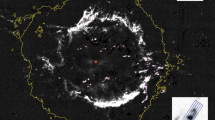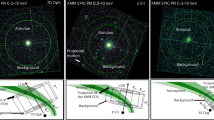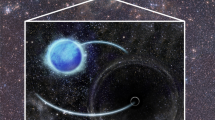Abstract
M15 is the prototypical collapsed-core globular cluster. Having undergone collapse, its core is believed now to be expanding, with energy for the re-expansion provided by binary stars, which turn gravitational potential energy into kinetic energy1. Because these binary stars are generally more massive than single stars, they will have settled to the centre of the cluster2. We report here that several of the stars at the core of M15 show Ca II H- and K-line emission, characteristic of young, rapidly rotating stars and close binaries3. We argue that the emission from M15 comes from primordial binaries, in which a period of spin-up has led to magnetic field generation by enhanced dynamo action, which in turn causes heating of the stellar chromospheres. If this interpretation is correct, the Ca H and K emission may provide an important diagnostic tool of the binary population in cluster cores, and thus of the cluster dynamics.
This is a preview of subscription content, access via your institution
Access options
Subscribe to this journal
Receive 51 print issues and online access
$199.00 per year
only $3.90 per issue
Buy this article
- Purchase on Springer Link
- Instant access to full article PDF
Prices may be subject to local taxes which are calculated during checkout
Similar content being viewed by others
References
Goodman, J. Dynamics of Dense Stellar Systems (ed Merritt, D) (Cambridge University Press, 1989).
Gao, B., Goodman, J., Conn, H. & Murphy, B. Astrophys. J. 370, 567–582 (1991).
Zwaan, C. in Mechanisms of Chromospheric and Coronal Heating (eds Ulmschneider, P., Priest, E. & Rosner, R.) (Springer, Heidelberg, 1991).
Aurière, M. & Cordoni, J.-P. Astr. Astrophys. Suppl. Ser 46, 347–354 (1981).
Rutten, R. G. M. Astr. Astrophys. 177, 131–142 (1987).
Herbig, G. Astrophys. J. 128, 259–266 (1958).
Bopp, B. W. & Stencel, P. E. Astrophys. J. 247, L131–L134 (1981).
Walter, F. M. & Basri, G. S. Astrophys. J. 260, 735–743 (1982).
Murphy, B. W., Cohn, H. N. & Hut, P. Mon. Not. R. astr. Soc. 245, 335–349 (1990).
Statler, T. S., Ostriker, J. P. & Cohn, H. N. Astrophys. J. 316, 626–659 (1987).
Lee, H. M. Astrophys. J. 319, 772–800 (1987).
Rasio, F. A. & Shapiro, S. L. Astrophys. J. (in the press).
Latham, D. W., Hazen-Liller, M. L. & Pryor, C. P. in Stellar Radial Velocities, IAU Colloq. No. 88 (eds Philip, A. G. D. & Latham, D.) (Reidel, Dordrecht, 1985).
Pryor, C. McClure, R. D., Fletcher, J. M. & Hesser, J. E. in Dynamics of Dense Stellar Systems (ed. Merritt, D.) (Cambridge University Press, UK, 1989).
Hut, P., Murphy, B. W. & Verbunt, F. Astr. Astrophys. 241, 137–141 (1991).
Pijpers, F. P. & Habing, H. J. Astr. Astrophys. 215, 334–346 (1989).
Ulmschneider, P. Astr. Astrophys. 222, 171–178 (1989).
Bowen, G. H. Astrophys. J. 329, 299–317 (1988).
Dupree, A. K. et al. Astrophys. J. 361, L9–L13 (1990).
Cederbloom, S. E. et al. in The Formation and Evolution of Star Clusters (ed. Janes, K.) (P.A.S.P. Conference Series, in the press).
Djorgovski, S., Piotto, G. & Mallen-Ornelas, G. in The Formation and Evolution of Star Clusters (ed. Janes, K.) (P.A.S.P. Conference Series, in the press).
Djorgovski, S., Piotto, G., Phinney, E. S. & Chernoff, D. Astrophys. J. (in the press).
Author information
Authors and Affiliations
Rights and permissions
About this article
Cite this article
Murphy, B., Rutten, R., Callanan, P. et al. Detection of binaries in the core of the globular cluster M15 using calcium emission lines. Nature 351, 130–132 (1991). https://doi.org/10.1038/351130a0
Received:
Accepted:
Issue Date:
DOI: https://doi.org/10.1038/351130a0
This article is cited by
Comments
By submitting a comment you agree to abide by our Terms and Community Guidelines. If you find something abusive or that does not comply with our terms or guidelines please flag it as inappropriate.



